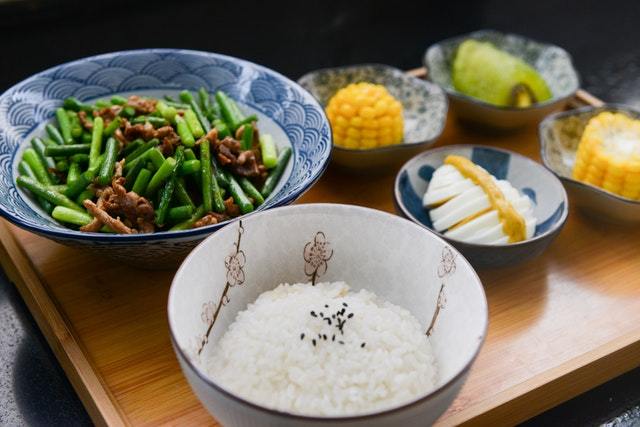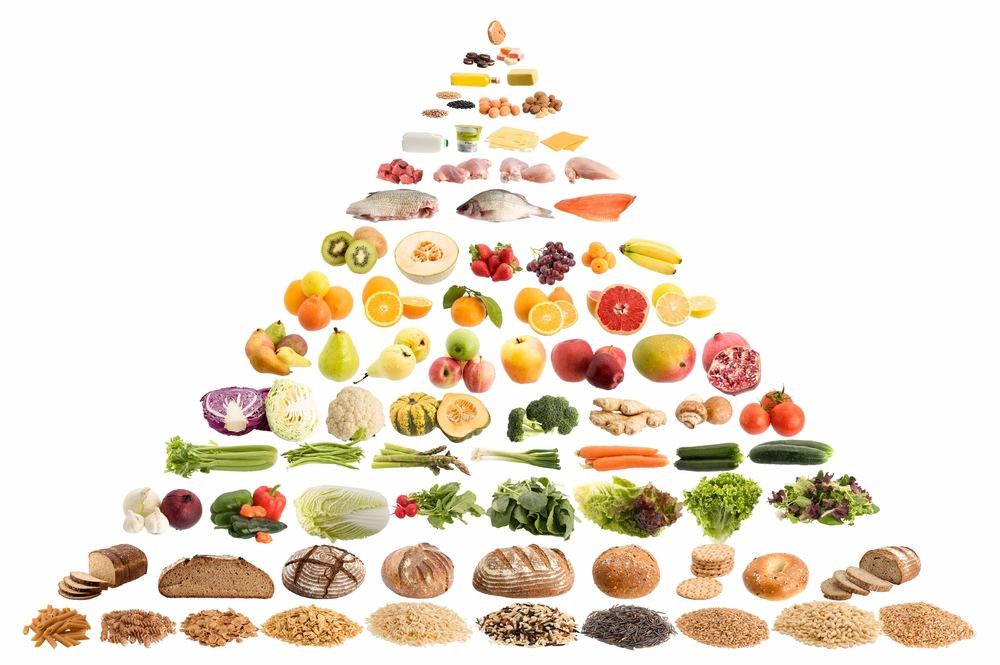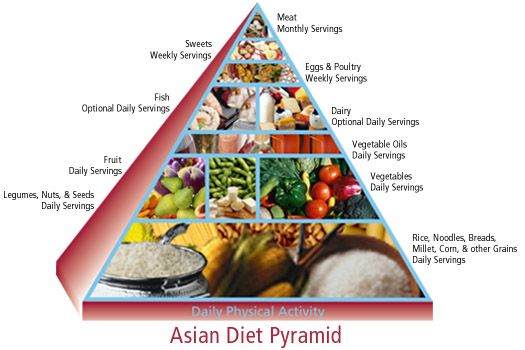
Source :- i2.wp . com
The Asian Diet Pyramid is a pyramid made of Asian Diet and food consumed by the people of the Asian country. The Asian Diet Pyramid represents a healthy diet. This pyramid’s main constitute is plant food and rice which provides 25-80% of the daily calory intake, a moderate amount of animal product and a large variety of healthy food.

Source :- media.mnn . com
What Is Asian Diet Pyramid?
People who follow Asian diet tend to be very healthy than others and also a low rate of chronic diseases which is common in western countries. The Asian Diet Pyramid is an eating habit pyramid of Asian Diet. Asian Diet Pyramid was developed by Oldways and exchange trust in conjunction with the Cornell-China-Oxford Project on Nutrition, Health and Environment, and the Harvard School of Public Health In 1995. It was released at the International Conference on the Diets of Asia in San Francisco in 1995.
The Asian Diet’s Pyramid represents the traditional cuisines of the region that includes Bangladesh, Cambodia, China, India, Indonesian, Japan, Laos, Malaysia, Mongolia, Myanmar, Nepal, North Korea, South Korea, Malaysia, Philippines, Singapore, Taiwan, Thailand, and Vietnam. Overall, the Asian Pyramid represents the traditional plant-based rural diet of these countries and emphasizes.

Source :- i.pinimg . com
Structure Of Pyramid:
A huge amount of vegetables, strong spices, rice and noodles, seafood, tofu, and soy products are the common food in traditional Asian diet. The Asian Diet Pyramid is made of 7 pyramids. Every pyramid indicates the amount of food type you consume and often you should consume. With increasing level, the amount of food consumption is decreased. Below I am giving detail on this pyramid. This is…
Level 1:
This is the bottom-most division in this Pyramid. This level indicates the daily consumption food or which food should consume daily. These foods are Rice, rice products, Noodles, Bread, Millet, Corn, and other whole grains. These food items are listed in level 1 as these foods are consumed most in Asian diet.
level 2:
This is the upper level of level 1. This level indicates the foods that we should consume daily. In this level is consist of fruits, legumes, seeds, nuts, and vegetables. These foods should consume the second most after level 1 food. In Asian diet vegetables and fruits are the second most consumed food that’s why this type of foods are listed in level 2.
Level 3:
This is the upper level of level 2 which is consist of vegetable oil. This Pyramid indicates that low consumption of vegetable oil daily. Vegetable oil is the consumed daily but low in an amount that’s why it is listed in level 3.
Level 4:
This is the upper level of level 3. This level is consist of fish, shellfish, and dairy. This level indicates an optional daily consumption of food. Asian consume fish dairy optional daily basis or an alternate day, that’s why the consumption of these foods are low and listed in level 4 of the pyramid.
Level 5:
This is the upper level of level 4. This level is consist of poultry like eggs and chicken. This level indicates the food we should consume on a weekly basis. Asian consume eggs or poultry meat one day in a week that’s why this is listed in level 5.
Level 6:
This is the upper level of level 5. This level is consist of sweets which should take on a weekly basis.
Level 7:
This is the upper level of level 6. This level is consist of red meat which should consume on monthly basis. This should be the minimum consumption. Red meat is consumed one time in a week that’s why it is listed in level 7.
So, this is the Asian diet pyramid according to an Asian diet.
How to Adapt the Asian Diet Pyramid to Indian Meals?
Adapting the Asian Diet Pyramid to Indian meals involves integrating traditional Indian foods while following the principles of a balanced, health-conscious approach. The Asian Diet Pyramid emphasizes plant-based foods, whole grains, vegetables, fruits, and moderate consumption of animal products. In India, the diversity of regional cuisines offers a wide variety of options that can align well with these principles. Here’s how you can adapt the Asian Diet Pyramid to fit an Indian context:
1. Foundation: Whole Grains and Starches:
Asian Diet Pyramid Focus:
The base of the pyramid includes whole grains like rice, noodles, and whole wheat products.
Indian Adaptation:
Staples: Whole wheat, brown rice, millet (bajra, jowar), quinoa, and oats.
Traditional Dishes:
- Chapati (whole wheat flatbread)
- Brown rice with dals (lentils)
- Upma made with whole wheat or oats
- Khichdi (a comfort food made with rice, lentils, and mild spices)
Why It Works:
Whole grains are rich in fiber, which helps with digestion and provides long-lasting energy. Millets and brown rice are good alternatives to refined white rice, which has fewer nutrients.
2. Vegetables and Fruits: A Colorful, Diverse Variety
Asian Diet Pyramid Focus:
The second tier emphasizes a wide variety of vegetables and fruits, ideally in each meal.
Indian Adaptation:
Vegetables:
Indian cuisine offers a rich variety of seasonal vegetables like spinach (palak), cauliflower, carrots, tomatoes, eggplant, bitter gourd (karela), okra (bhindi), and pumpkin.
Dishes:
- Sabzi (vegetable curries, like aloo-gobhi or baingan bharta)
- Sautéed vegetables (like stir-fried greens with mustard oil or ghee)
- Vegetable soups (like tomato soup or moong dal soup)
Fruits:
Opt for a variety of seasonal fruits like mangoes, papayas, guavas, pomegranates, apples, bananas, and citrus fruits.
Dishes:
- Fresh fruit salads, like a simple combination of papaya, banana, and orange
- Smoothies made from yogurt and fruits
Why It Works:
Vegetables and fruits provide vital vitamins, minerals, and fiber, promoting digestion, immunity, and overall health. Indian meals often include a variety of spices that can complement these nutrients.
3. Legumes, Beans, and Protein-Rich Foods
Asian Diet Pyramid Focus:
Protein comes primarily from plant-based sources, like legumes, beans, tofu, and soy products, with moderate portions of fish and chicken.
Indian Adaptation:
Legumes:
Dals (lentils), chickpeas, kidney beans (rajma), and mung beans are staples in Indian cuisine and provide a great plant-based protein source.
Dishes:
- Dal tadka (lentil soup with tempering)
- Chole (chickpea curry)
- Rajma (kidney bean curry)
- Pulses in khichdi (rice and lentil porridge)
Animal Protein:
If you consume non-vegetarian food, opt for lean sources like fish, chicken, or eggs, which are common in coastal regions and among non-vegetarians.
Dishes:
- Grilled chicken or tandoori fish
- Egg curry (made with tomatoes, onions, and spices)
Why It Works:
Legumes and beans are excellent plant-based protein sources that provide fiber and essential nutrients. Including lean animal proteins in moderation ensures a balance between plant and animal-based nutrition.
4. Healthy Fats in Moderation:
Asian Diet Pyramid Focus:
The pyramid suggests healthy fats, especially from plant sources like olive oil, nuts, seeds, and avocados, while limiting saturated fats.
Indian Adaptation:
Healthy Fats:
- Ghee (clarified butter) in moderation
- Mustard oil, coconut oil, and olive oil for cooking
- Nuts and seeds like almonds, walnuts, flaxseeds, and chia seeds
- Coconut (used in curries or as a garnish)
Traditional Dishes:
- Palak paneer (spinach and cottage cheese) cooked with ghee
- Moong dal chilla (lentil pancakes with a sprinkle of sesame seeds)
- Coconut chutney served with dosa or idli
Why It Works:
Healthy fats support brain function, heart health, and provide satiety. Ghee and oils like mustard or coconut are common in Indian cuisine and offer a natural source of fat when used in moderation.
5. Animal Products: Limited and Balanced:
Asian Diet Pyramid Focus:
Moderate intake of animal products like fish, poultry, eggs, and dairy is encouraged, with less focus on red meats.
Indian Adaptation:
Dairy Products:
Dairy is a significant part of Indian cuisine, particularly in the form of milk, yogurt, paneer (cottage cheese), and buttermilk.
Dishes:
- Paneer tikka (grilled cottage cheese)
- Lassi (yogurt-based drink)
- Dahi rice (yogurt with rice)
Moderate Animal Protein:
Choose fish (especially in coastal regions), chicken, or eggs, but limit red meat consumption.
Dishes:
- Fish curry (made with spices and coconut)
- Egg bhurji (scrambled eggs with onions, tomatoes, and spices)
Why It Works:
Dairy provides calcium and protein, and lean animal products offer quality protein with fewer saturated fats compared to red meats. Dairy-based dishes are widely loved in India and can be part of a balanced diet.
6. Sweets and Snacks: Enjoy in Moderation:
Asian Diet Pyramid Focus:
Sweets and snacks should be consumed sparingly.
Indian Adaptation:
Moderation is Key:
- While Indian sweets like gulab jamun, rasgulla, and kheer are beloved, they should be enjoyed occasionally, as part of a balanced diet.
- Healthier Alternatives:
- Fruit-based sweets (like kesar mango kulfi)
- Nuts and seeds as snacks
- Chana chaat (chickpeas with onions, tomatoes, and spices)
Why It Works:
Indian sweets often contain refined sugars and fats. Opting for healthier, whole-food-based snacks and limiting sweets helps manage calorie intake and prevent excessive sugar consumption.
Conclusion:
The Asian Diet Pyramid can be easily adapted to Indian meals by incorporating the wide variety of grains, vegetables, legumes, dairy, and lean proteins that form the foundation of Indian cuisine. By focusing on whole grains, plant-based foods, and moderate portions of healthy fats and animal products, you can create a balanced diet that supports overall health, energy, and well-being. The key is to enjoy the diverse and flavorful foods that Indian cuisine offers while adhering to principles of portion control, variety, and balance.
FAQ:
Q. Why is it important to balance carbs and proteins in my diet?
A. Balancing carbohydrates and proteins is crucial for optimal health, energy, and muscle function. Carbs provide your body with immediate energy, while proteins support muscle repair, growth, and overall body functions. A proper balance ensures sustained energy levels throughout the day, improves muscle recovery post-exercise, and helps maintain a healthy metabolism.
2. How many grams of protein and carbs should I consume daily?
A. The exact amount depends on your individual needs, such as activity level, age, gender, and goals (e.g., weight loss, muscle gain, or general health).
Protein: A general guideline is to consume around 0.8 to 1 gram of protein per kilogram of body weight for the average person. If you’re an athlete or trying to build muscle, this may increase to around 1.2 to 2 grams per kilogram.
Carbohydrates: Carbs should make up 45-65% of your total daily calories, depending on your activity level. For moderate activity, a person may consume between 3 to 6 grams of carbs per kilogram of body weight.
It’s always best to consult a nutritionist or dietitian to tailor the amounts based on your personal goals.
Q. Can I eat carbs and protein together?
A. Yes, eating carbs and protein together is highly beneficial, especially after a workout. When combined, they work synergistically to provide both energy (from carbs) and aid in muscle recovery (from protein). For example, a meal like chicken and rice or a vegetable stir-fry with quinoa ensures that both macronutrients are available to your body simultaneously for optimal function and recovery.
Q. What are some good sources of healthy carbs and proteins?
A. Here are some healthy options:
Carbohydrates:
- Whole grains (brown rice, quinoa, oats, barley)
- Fruits (bananas, berries, apples, oranges)
- Vegetables (sweet potatoes, leafy greens, carrots)
- Legumes (lentils, chickpeas, black beans)
Proteins:
- Lean meats (chicken, turkey, fish)
- Plant-based proteins (tofu, tempeh, lentils, chickpeas)
- Dairy (Greek yogurt, cottage cheese)
- Eggs
- Nuts and seeds (almonds, chia seeds, pumpkin seeds)
Q. Can I eat carbs and proteins in one meal if I want to lose weight?
A. Yes, you can eat both carbs and protein in a single meal and still lose weight. The key is portion control and choosing healthier, nutrient-dense sources. Balancing protein with moderate portions of complex carbs (like whole grains or vegetables) will keep you full for longer, reduce cravings, and help maintain muscle mass while losing fat.
Q. Is it better to focus more on protein than carbs for weight loss?
A. Protein is essential for preserving lean muscle mass, especially during weight loss, but carbs are also important as they provide energy and support overall health. A diet that’s too low in carbs may lead to fatigue, lack of energy, and poor workout performance, which could ultimately hinder weight loss efforts. A balanced approach with slightly higher protein intake, moderate carbs, and healthy fats is often the most sustainable for weight loss and long-term health.
Reference Link:
- Introducing the Updated Asian Diet Pyramid
- Food and Flavors of the Asian Heritage Diet
- Cornell Scientists Help to Develop Asian Diet Pyramid
- What Is the Asian Diet? Potential Health Benefits, Food List
- New Food Pyramid